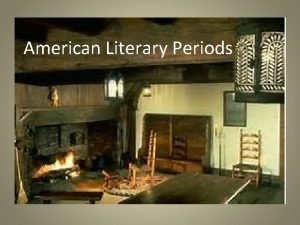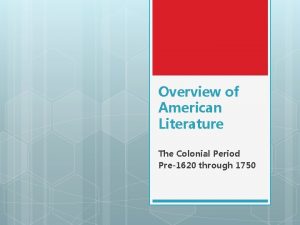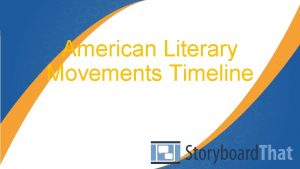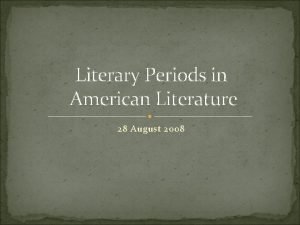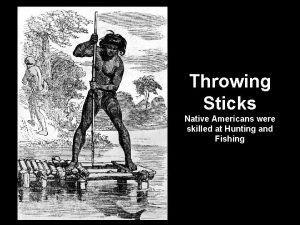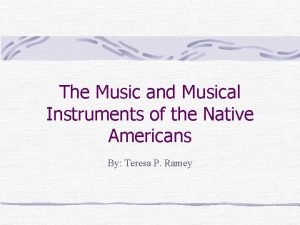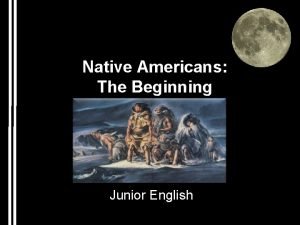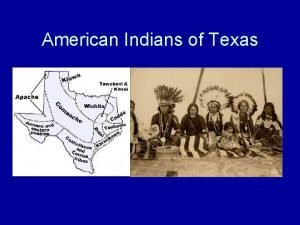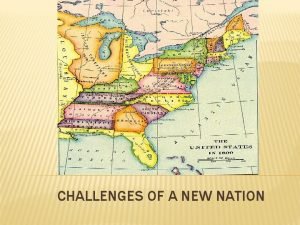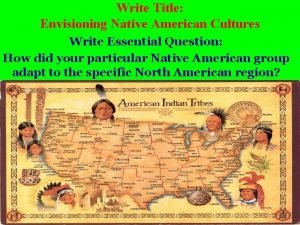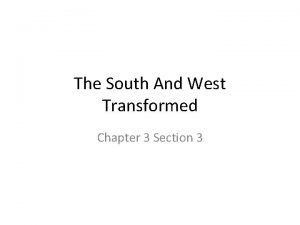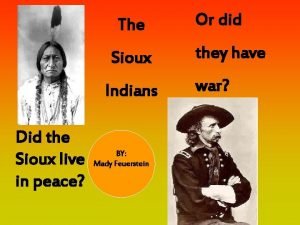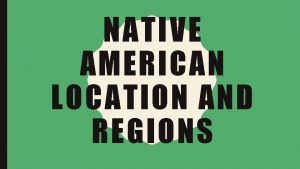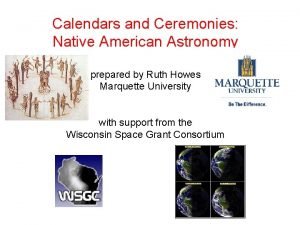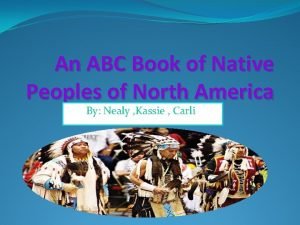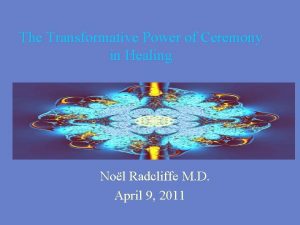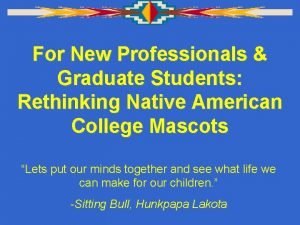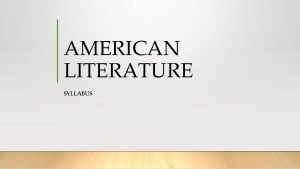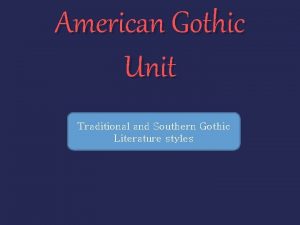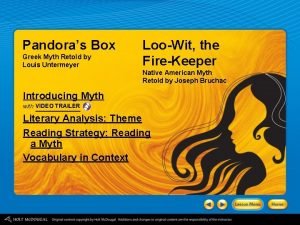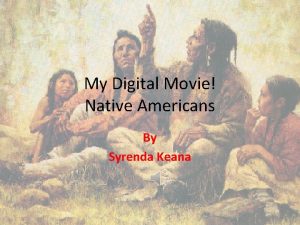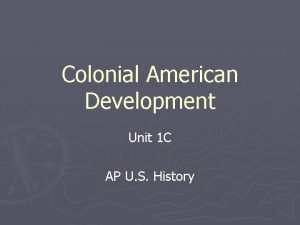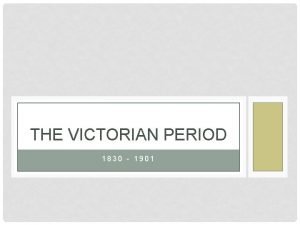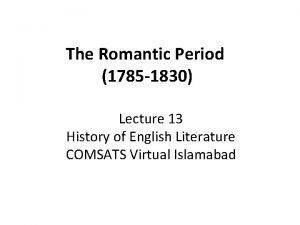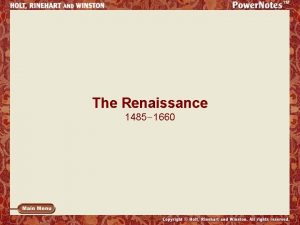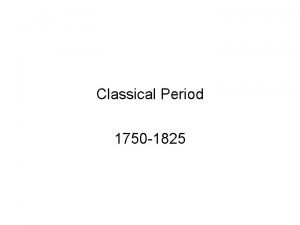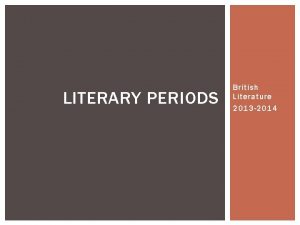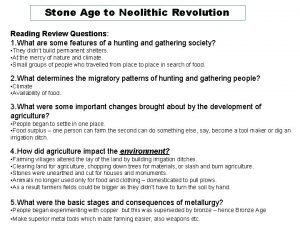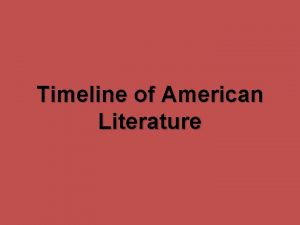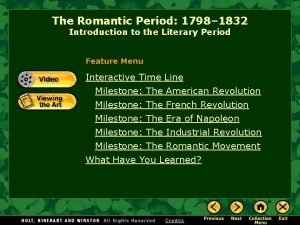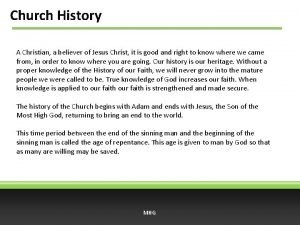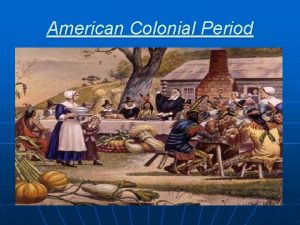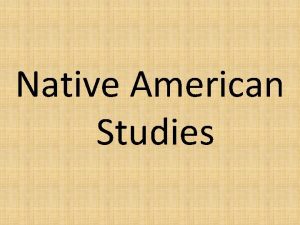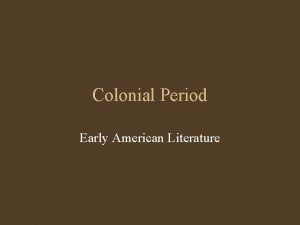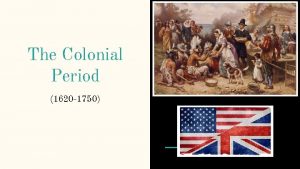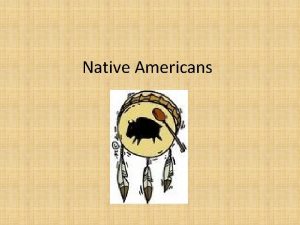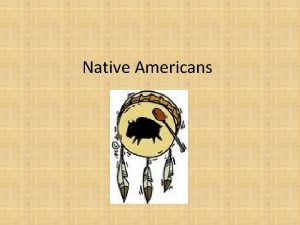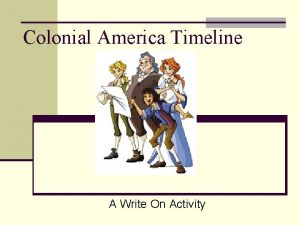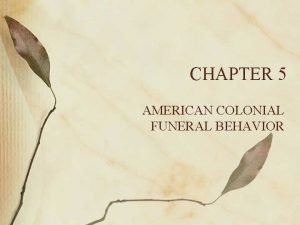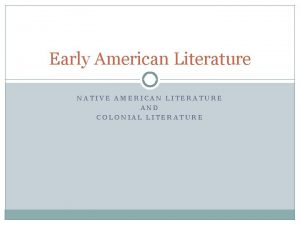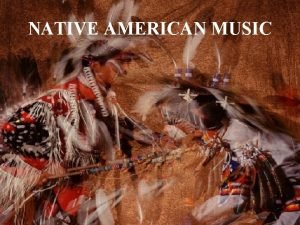American Literary Timeline Native American Colonial Period Age
![American Literary Timeline Ø Ø Ø [Native American] Colonial Period Age of Reason Romanticism American Literary Timeline Ø Ø Ø [Native American] Colonial Period Age of Reason Romanticism](https://slidetodoc.com/presentation_image_h2/055aec056600157756beec264711c380/image-1.jpg)



























![[Sarah] Margaret Fuller (1810 -1850) • Fuller was born in Cambridgeport, Massachusetts. She learned [Sarah] Margaret Fuller (1810 -1850) • Fuller was born in Cambridgeport, Massachusetts. She learned](https://slidetodoc.com/presentation_image_h2/055aec056600157756beec264711c380/image-29.jpg)

![Mark Twain [Samuel Clemens] (1835 -1910) • Twain is know by many as the Mark Twain [Samuel Clemens] (1835 -1910) • Twain is know by many as the](https://slidetodoc.com/presentation_image_h2/055aec056600157756beec264711c380/image-31.jpg)


















- Slides: 49
![American Literary Timeline Ø Ø Ø Native American Colonial Period Age of Reason Romanticism American Literary Timeline Ø Ø Ø [Native American] Colonial Period Age of Reason Romanticism](https://slidetodoc.com/presentation_image_h2/055aec056600157756beec264711c380/image-1.jpg)
American Literary Timeline Ø Ø Ø [Native American] Colonial Period Age of Reason Romanticism Transcendentalism Anti-Transcendentalism Ø Ø Ø Realism Naturalism Regionalism Modernism Contemporary ***Page 30 in your Study Guide***

Native American Literature • • Pre “American” Literature Oral Tradition Poems, Songs, & Stories Focused on the natural world & man’s relationship to nature & the Earth

Colonial Period Early America-1776 This period was at the very beginnings of America and it made way for the rest of the country’s literature. In the first stages of America there writers, such as Thomas Hariot, who wrote A Brief and True Report of the New-Found Land of Virginia in 1588; in which he described “The Americas” in words and picture. The book was quickly translated into Latin, French, and German; it was a window for the Old World to see an embellished version of the New World. Others that dominated this era were the Puritans whose definition of good writing was writing that brought home a full awareness of the importance of worshipping God and of the spiritual dangers that the soul faced on Earth, and the literature that was produced by the Puritans reflected this. Authors of the Colonial Period Edward Taylor John Woolman Anne Bradstreet William Bradford

Age of Reason Late 1770 s to Early 1800 s This period was a time when authors were focused more on their own reasoning rather than simply taking what the church taught as fact. During this period there was also cultivation of patriotism. The main medium during that period were political pamphlets, essays, travel writings, speeches, and documents. Also during this period many reforms were either made or requested, for instance during this time the Declaration of Independence was written. Authors of the Age of Reason Abigail Adams Benjamin Franklin Thomas Jefferson Thomas Paine

Romanticism 1800 -1850 After the “Age of Reason” came to an end, the people of America were tired of reality; they wanted to see life as more than it was. This was the Era of Romantics. The main medium that presented itself at that time were short stories, poems, and novels. During this era, as opposed to the “Age of Reason” the imagination dominated; intuition ruled over fact, and there was a large emphasis on the individual/common man, and on nature or the natural world. Gothic literature, which is a sub-genre of Romanticism, was also introduced at this time; this genre included stories about characters that had both good and evil traits. Gothic literature also incorporated to use of supernatural elements. Authors of Romanticism Washington Irving Nathaniel Hawthorne Edgar Allen Poe Herman Melville

Transcendentalism 1840 -1855 This movement pushed America from the elaborate and fantasy-like writings displayed in the period of Romanticism into a period of literature that stressed individualism and mature self-reliance. Often Transcendentalists used nature to gain knowledge or to return to a life of self-reliance and individualism. It also stressed the fundamental idea of a unity between God and the world, that each person was a microcosm for the world. Unlike many European groups, the Transcendentalists never issued a manifesto. They insisted on the differences in each individual. Authors of Transcendentalism Ralph Waldo Emerson Henry David Thoreau Walt Whitman [Sarah] Margaret Fuller

Anti-Transcendentalism 1840 -1855 During the same time period when Transcendentalism was taking place, its opposite, Anti-Transcendentalism, was also happening. As Authors of opposed to Transcendentalism, which focused on the natural world and its relationship to humanity and the quest for understanding of the human spirit, Anti-Transcendentalism Anti- Transcendentalism focused on the limitations Herman Melville of mankind, and its potential destructiveness of the Nathaniel Hawthorne human spirit. For instance: water brings life, but its excess, e. g. a flood, can bring death and destruction. (Notice how they sometimes use nature in their writings to reflect what goes in with humans. Example: In The Scarlet Letter, the forest reflects Pearl’s wild nature; it’s the only place Hester and Dimmesdale can be free, etc. )

Realism 1865 -1915 This literary movement took place during the Civil War; at a time when a war was taking place people were tired of Transcendentalism and Anti-Transcendentalism. For one thing, these Authors of Realism movements were both extremes of the same spectrum: one was nice, happy, and “frilly; ” the Mark Twain [Samuel Clemens] other was dark and destructive. People wanted to Bret Harte see things how they were, so Realism came about. Realism also came about as a reaction to Sarah Orne Jewett Romanticism, in which there were heroic James Henry characters, adventures, and strange or unfamiliar settings. In response, Realism authors tried to write truthfully and objectively about ordinary characters in ordinary situations.

Naturalism 1865 -1915 Writers of the Naturalist literary movement that took place in the late nineteenth and early twentieth century tended to view people as hapless victims of immutable natural laws. Naturalism is closely related to Realism, but it usually views the world from a darker perspective. In Naturalism it is widely shown that free will is an illusion—that things that happen in the universe happen, and could not happen any other way. Another defining characteristic of Naturalism is that its characters’ lives are shaped by forces they cannot control. Authors of Naturalism Stephen Crane Jack London Theodore Dreiser Frank Norris

Regionalism 1865 -1915 Regionalism was a literary movement in which authors would write stories about specific geographical areas. By writing about regions, the authors explore the culture of that area, including Authors of its languages, customs, beliefs, and history. Regionalism Willa Cather Writers in this movement tried not only to show the region they wrote about to their readers, but they also made an attempt at a sophisticated sociological or anthropological treatment of the culture of the region. William Faulkner Kate Chopin Frank Norris

Modernism 1915 -1946 This type of writing is one of the most experimental types. Modernist authors used fragments, stream of consciousness, and Authors of interior dialogue. The main thing that Modernism authors were trying to achieve with Ernest Hemingway Modernism was a unique style, one that they F. Scott Fitzgerald could stand out for, and be known for. John Steinbeck During this period technology was Robert Frost taking incredible leaps, and two World Wars took place, resulting in destruction of a global scale. The younger generation began to take over the main stage.

Contemporary 1946 -present In the years since the Modernism period, American authors have begun to Authors of the write from a plethora of genres. Contemporary Americans have realized that the best way Period to go is have many authors writing what J. D. Salinger ever it is they are best at. That’s exactly Stephen King what has happened, there are more Joyce Carol Oates different types of writing being done at one time than at any other period in Robert Jordan history; Fantasy, fiction, science fiction, horror, Political writings, romantics, plays, and poems, anything and everything.

Know the following literary terms: Character Diction Imagery Exposition Falling Action Flashback Point of View Theme Metaphor Personification Antagonist Denotation Mood Rising Action Resolution Foreshadowing Setting Tone Simile Alliteration Protagonist Connotation Plot Climax Conflict Suspense Style Figures of Speech Oxymoron


Edward Taylor (c. 1644 -1729) • Taylor was a Minister who studied at Harvard College; his works were never published until they were discovered in 1930 s. He wrote such pieces as Metrical History of Christianity, which mainly a history of Christian martyrs. Colonial Period

John Woolman (1720 -1772) • The best known work by a Quaker was written by this man. Simply titled Journal, this 1774 journal was a complete and full account of his life in a pure, heartfelt style of great sweetness that attracted many American and English writers for many years after Woolman’s death. Colonial Period

Anne Bradstreet (c. 1612 -1672) • The first publication of a book of poems in America was also the first publication by a woman in America. She also wrote The Tenth Muse Lately Sprung Up in America in 1650. Colonial Period

William Bradford (1590 -1657) • He was elected governor of Plymouth shortly after the pilgrims landed in on Plymouth Rock. He was essentially the first historian of the new colonies. His participation in the voyage of the Mayflower and being governor made him the ideal person for this job. He wrote Of Plymouth Plantation in 1651. Colonial Period

Abigail Adams (1744 -1818) • She wrote letters that campaigned for women’s rights. Her grandson, Charles Francis Adams, published The Familiar Letters of John Adams and His Wife Abigail During the Revolution, which were just what they said they were, letters written by Abigail and her husband. Age of Reason

Benjamin Franklin (1706 -1790) • Franklin is well known worldwide for his discoveries in the world of science and also for works that he contributed to, such as the Declaration of Independence, and his theories on electricity. Many of his works were all new ideas and things people never thought of before. Age of Reason

Thomas Jefferson (1743 -1826) • Jefferson is best known for writing the Declaration of Independence. The document came about as a response to the times; people were now thinking for themselves, and one of the major thing the Americans discovered was that they didn’t need England. Jefferson wrote the Declaration of Independence to formally state that. Age of Reason

Thomas Paine (1737 -1809) • Paine mostly wrote pamphlets that would spur ideas and immediate action. In the document "The American Crisis, " Paine wrote about the oppression that America suffered from Britain, and propelled America into a war with Britain. Paine, to this day, is well known for his propaganda. Age of Reason

Washington Irving (1789 -1851) • Irving was the first “famous” American author; he’s also known as the “Father of American Literature. ” He wrote travel books, short stories, and satires. Some of his works include The Legend of Sleepy Hollow, Rip Van Winkle, and The Devil and Tom Walker. Romanticism

Edgar Allen Poe (1809 -1849) • Poe had a bad childhood that made him despise the world, and his works reflected his experiences. He is credited for creating the modern short story and the detective story. He also challenged two long-standing theories, one, a poem had to be long, and two, a poem had to teach you something. Some of his works include, "The Raven", "Bells", "Annabel Lee", and "Dream. " Romanticism

Herman Melville (1819 -1891) • In his time Melville was not entirely recognized, however, in recent years he has been considered one of the greatest novelists of all time. He is most well known for his epic novel Moby Dick. Romanticism Anti-Transcendentalism

Ralph Waldo Emerson (1803 -1882) • Emerson had a strong sense of a religious mission, although he was accused of subverting Christianity. He left the church saying, “to be a good minister, it was necessary to leave the church. ” Some of his mayor works include Nature, published in 1836. Transcendentalism

Henry David Thoreau (1817 -1862) • Thoreau Lived his life to do just that: to live his life. He was never rich and for the most part lived with little money all his life. The work he is best known for is Walden, published in 1854. Transcendentalism

Walt Whitman (1819 -1892) • Whitman was born on Long Island, and was, for most of his working life, a carpenter. He was a man of the people. Most of his education was achieved on his own after he left school at the age of eleven. His major work was entitled Leaves of Grass, published in 1855; over the years he made many rewrites for this book. Some of his famous poems are "Crossing Brooklyn Ferry, " "Out of the Cradle Endlessly Rocking, " and "When Lilacs Last in the Dooryard Bloom'd. " Transcendentalism
![Sarah Margaret Fuller 1810 1850 Fuller was born in Cambridgeport Massachusetts She learned [Sarah] Margaret Fuller (1810 -1850) • Fuller was born in Cambridgeport, Massachusetts. She learned](https://slidetodoc.com/presentation_image_h2/055aec056600157756beec264711c380/image-29.jpg)
[Sarah] Margaret Fuller (1810 -1850) • Fuller was born in Cambridgeport, Massachusetts. She learned Greek and Latin at a very young age, and later learned German and Italian. After her father, a congressman, died, she became a schoolteacher. She worked with Ralph Emerson as editors of The Dial, a literary and philosophical journal, for which she wrote many articles including “The Great Lawsuit: Man versus Woman, Woman versus Man; ” in which she spoke for the equality of men and women. Some of her other works include Summer on the Lakes, published in 1844, and Women in the Nineteenth Century, published in 1845. Transcendentalism

Nathaniel Hawthorne (1804 -1864) • Hawthorne was a Puritan who utilized his writings to express his dark, and gloomy outlook on life. Some of his works include; Twice Told Tales, published in 1837; The Scarlet Letter, published in 1850; and The House of the Seven Gables, published in 1851. Anti-Transcendentalism Romanticism
![Mark Twain Samuel Clemens 1835 1910 Twain is know by many as the Mark Twain [Samuel Clemens] (1835 -1910) • Twain is know by many as the](https://slidetodoc.com/presentation_image_h2/055aec056600157756beec264711c380/image-31.jpg)
Mark Twain [Samuel Clemens] (1835 -1910) • Twain is know by many as the greatest American humorist and one of our greatest novelists. He was known for using vernacular, exaggeration, and deadpan narration to create humor. Twain wrote many great novels, including the Adventures of Tom Sawyer, published in 1876, and The Prince and the Pauper, published in 1881. Realism

Bret Harte (1836 -1902) • Harte was born in New York, and later worked in California, on The Californian writing stories. He worked with other wellknown authors as well, while at The Californian, authors like Mark Twain, Charles Warren Stoddard, and Prentice Mulford. He was later appointed Secretary of the United States Mint Branch at San Francisco; he held this office until 1870. He then became the editor of Overland Monthly, where he published "The Luck of Roaring Camp, " which brought him instant fame. Some of his works included; "The Heathen Chinese, ” a poem published in 1870, Devil's Ford, "The Twins of Table Mountain, " "By Shore and Sedge, " and "A Millionaire of Rough and Ready. " Realism

Sarah Orne Jewett (1849 -1909) • Jewett grew up with books all around her, it was only fitting she should become a writer. The early years of her life were much like the story she wrote in A Country Doctor. Some of her works include Miss Tempy's Watchers, originally published in 1888, The Dulham Ladies, originally published in 1886, and A White Heron, originally published in 1886. Realism

James Henry (1843 -1916 ) • Henry’s father was an important theorist and lecturer, and his older brother was a famous American philosopher, William James. He attended Harvard College. His early stories depict the leisurely life of the well-to-do. In his time he wrote many short stories including “The Short Story of a Year, ” published in 1865, “Gabrielle de Bergerac, ” published in 1869, and “Guest's Confession. ” Realism

Stephen Crane (1871 -1900) • Crane’s writing was known for attacking patriotism, individualism, and organized religion; it also confronted the meaninglessness of the world. His work was also very well known for its imagery and symbolism. The work he is most famous for is The Red Badge of Courage, which was set in the Civil War. Some of his other works include The Open Boat, published in 1894, and “An Episode of War, ” originally published in 1890. Naturalism

Jack London (1876 -1916) • London was born in San Francisco, California. He lived a hard life, switching from job to job for whatever money he could get, after his father abandoned him at a young age. He is one of the most highly acclaimed writers of all time; his stories of life and death struggles are vivid and engaging. Some of his works include The Call of the Wild, published in 1903, White Fang, published in 1906, “Lost Face, ” published in 1910, and “The Night Born, ” published in 1913. Naturalism

Theodore Dreiser (1871 -1945) • One of Dreiser's favorite fictional devices was the use of contrast between the rich and the poor, the urbane and the unsophisticated, and the power brokers and the helpless. Some of his works include Twelve Men, published in 1919, A Book About Myself, published in 1922, The Color of a Great City, published in 1923, and An American Tragedy, published in 1925. Naturalism

Frank Norris (1870 -1902) • Norris studied in Paris, at the University of California, and at Harvard. He also spent several years as a war correspondent in South Africa (1895 -96) and Cuba (1898). Some of his works include The Responsibilities of the Novelist, published in 1903, The Octopus, published in 1901, and The Pit, published in 1903. Naturalism

Willa Cather (1873 -1947) • Cather has been called one of the most interesting female writers in American literary history. She was a teacher, a journalist and a critic as well as a writer. She has a talent for presenting settings and characters that are rich in language and imagery. She also won a Pulitzer Prize. Some of her works include April Twilights, published in 1903, and O Pioneers!, published in 1913. Regionalism

William Faulkner (1897 -1962) • Faulkner served in both the Canadian and the British Royal Air Force. He wrote most of his novel on a farm in Oxford, Mississippi. Some of his novels included The Sound and the Fury, Absolom!, and As I Lay Dying. Regionalism

Kate Chopin (1851 -1904) • Chopin loved literature as a child, and secluded herself in it after her grandmothers death. She never achieved much until 1884 when she finally decided to pursue a career in writing. Some of her writings include "Desiree’s Baby, " published in 1893; "The Awakening, " published in 1899. Regionalism

Ernest Hemingway (1899 -1961) • Hemingway won a Pulitzer Prize and Noble Peace Price for Literature. He used concise, direct, spare, objective, precise, rhythmic writing styles to create larger than life heroes, big game hunters, etc. Some of his works include; The Sun Also Rises, published in 1922; A Farewell To Arms published in 1929; For Whom the Bell Tolls, published in 1940. • “There is nothing to writing. All you do is sit down at a typewriter and bleed. ” –Ernest Hemingway Modernism

F. Scott Fitzgerald (1896 -1940) • Fitzgerald wrote about his times. In his novel The Great Gatsby, published in 1925, he wrote about the roaring twenties, a time when no one cared about the future and they had fun with what they had then. Some of his other works include This Side of Paradise, published in 1920, and The Beautiful and the Damned, published in 1922. Modernism

John Steinbeck (1902 -1968) • Steinbeck wrote about the both the pains and joys of life. His best-known work The Grapes of Wrath, published in 1939, told the story of families struggling to survive and stay together during the depression. In other works like Tortilla Flat, published in 1935, Steinbeck wrote about the joys of life. Some of his other works include East of Eden, published in 1952, Of Mice and Men, published in 1937, and The Pearl, published in 1947. Modernism

Robert Frost (1874 -1963) • America’s best known and most loved poet, Frost wrote his poems in a traditional verse form. He used the plain speech of rural New Englanders. Some of his works include “Death of the Hired Man, ” published in 1951, “Birches, ” published in 1920, and “The Road Not Taken, ” published in 1920. Modernism

J. D. Salinger (b. 1919) • Salinger studied at NYU, and Columbia University. After which he decided to devote his life to his writing. His writing career was interrupted by World War I, where he served in the U. S. Army. His most well-known work was his novel The Catcher in the Rye, published in 1951, a novel about a high school student who tries to run away from a life that he thinks is “phony. ” Some of his works are A Perfect Day for Bananafish, published in 1948, For Esmé With Love and Squalor, published in 1950. Contemporary

Stephen King (b. 1947) • King writes novels that frighten people. Some of his major works are Carrie, published in 1974, The Shining, publishing in 1998, Salem's Lot, published in 1993, and The Stand, published in 1991. Contemporary

Joyce Carol Oates (b. 1938) • Oates received a type writer at the age of fourteen and trained herself to write novel after novel through high school and college. She earned an M. A. in English at the University of Wisconsin. Some of her works include Blonde, published in 2000, Wonderland, published in 1971, and The Tattooed Girl, published in 2003. Contemporary

Robert Jordan (b. 1948) • He went to the Citadel, the Military College of South Carolina, where he received a degree in physics. Jordan’s main area of expertise is in the genre of fantasy. He is currently in the process of writing a series of novel entitled The Wheel of Time. Some of the novels from this series are The Eye of the World, published in 1990; Crossroads of Twilight, published in 2003; and The Novel: New Spring published in 2004. Contemporary
 Iron age dates
Iron age dates Iron age bronze age stone age timeline
Iron age bronze age stone age timeline American colonial period literature
American colonial period literature American literature colonial period
American literature colonial period Timeline of american literary movements
Timeline of american literary movements American literature period
American literature period Roman period floral design
Roman period floral design Greek floral arrangements
Greek floral arrangements Pre-colonial period
Pre-colonial period Native american throwing stick
Native american throwing stick Native american musical instruments
Native american musical instruments First people in the world
First people in the world Native american religious beliefs
Native american religious beliefs Characteristics of native american literature
Characteristics of native american literature Medicine wheel colours
Medicine wheel colours Native american literature characteristics
Native american literature characteristics Native american dwellings
Native american dwellings What candy is two female pronouns
What candy is two female pronouns Native american youth and family center
Native american youth and family center Native american connections housing
Native american connections housing Native american important facts
Native american important facts Native american tribes
Native american tribes What three circumstances hurt native americans
What three circumstances hurt native americans Sioux writing
Sioux writing Skywalkers native american
Skywalkers native american Native american tribes in the united states
Native american tribes in the united states Lesson 1 the peoples of north america and mesoamerica
Lesson 1 the peoples of north america and mesoamerica Native american calendars
Native american calendars Native american abc book
Native american abc book Native american letting go ceremony
Native american letting go ceremony Native american morals and values
Native american morals and values Belief me
Belief me Indian burial grounds candy
Indian burial grounds candy Southern literature syllabus
Southern literature syllabus American gothic definition
American gothic definition Pandora's box and loo-wit the fire keeper
Pandora's box and loo-wit the fire keeper Native american writing
Native american writing Keana inu
Keana inu Native american healing prayers for the sick
Native american healing prayers for the sick Colonial american development
Colonial american development Domestic propriety
Domestic propriety The romantic period 1785 to 1832
The romantic period 1785 to 1832 Timeline renaissance
Timeline renaissance Interwar period timeline
Interwar period timeline Classical period timeline
Classical period timeline Time line of literary periods in british literature
Time line of literary periods in british literature Difference between stone age and modern age
Difference between stone age and modern age Puritan age timeline
Puritan age timeline The era of change 1798-1832
The era of change 1798-1832 Apostolic age timeline
Apostolic age timeline


